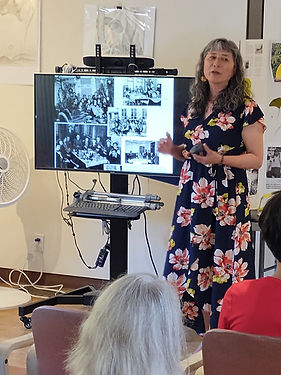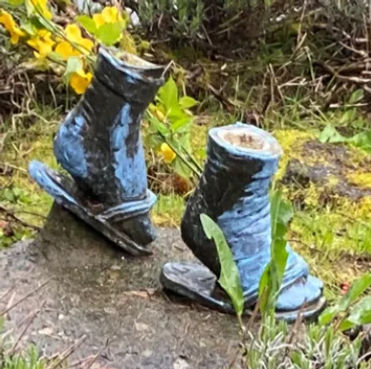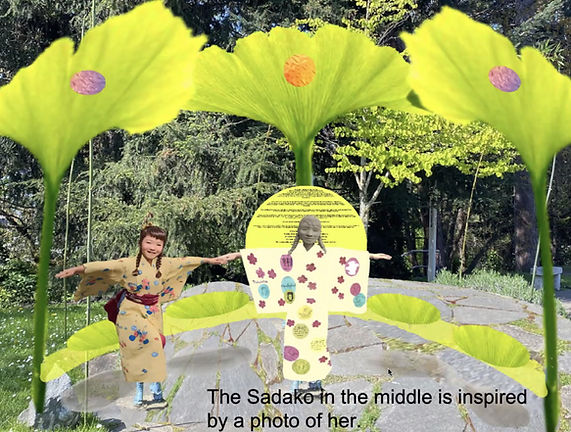Process of Artist Selection
The Sadako Renewal Project community learned that original design of the statue could not be restored, as local and state art commissions discourage new public commissions of bronze because of recent rampant thefts. Also, the original cast of the statue no longer exists.
Regional public art managers advised them to search for a public artist to propose a new artwork that was theft proof. The project team asked that the original feet of the statue designed by artist Daryl Smith to remain as part of the artwork.
The process to select a new artist began in January 2025, when public art management team Elisheba Johnson and Marcia Iwasaki drew up a list of 200 possible artists from Oregon and Washington, whose practice and experience was aligned with this project. After narrowing this list to 34 artists, Johnson and Iwasaki facilitated a jury for the Sadako Renewal Project that produced three finalists to propose public art plans. We express our appreciation to the artists who participated in this meaningful selection process. Saya Moriyasu's art plan was selected in May 2025.


The remaining feet from artist Daryl Smith's Sadako statue.

Image of the public art plan, with a superimposed historic photo of Sadako Sasaki in her yukata.

Public Art Plan
Concept Overview
In 2024, Seattle’s Peace Park suffered a heartbreaking loss: the original Sadako statue was stolen and cut from its base, leaving only her bronze feet behind.My response is not to replace what was taken, but to create a new form—one that encircles, protects, and invites.In Sadako Reimagined (working title), I tell a new version of her story: a young Sadako in a kimono, arms extended in a joyful, open gesture, her sleeves unfolding like wings. The sculpture suggests flight, joy, and resilience. Sadako’s original bronze feet sculpted by Daryl Smith in 1990 remain visible and gently held within this new form. In this way, an act of destruction becomes the foundation for transformation.
Relationship to Place
The Seattle Peace Park sits on the land of the Coast Salish peoples, including the Duwamish Tribe, whose relationship with this place is vital and ongoing. The nearby Cheshiahud Lake Union Trail honors a Duwamish couple who resisted removal and remained at x̌áxəʔču (Lake Union). This is a reminder that peace is not the absence of conflict but the active presence of memory and belonging. My sculpture honors that legacy through proximity, gesture, and holding space. The ginkgo, once native to this region, connects back to time immemorial. Ginkgo trees in Hiroshima survived the atomic bomb and continue as living symbols of resilience and collective memory.
Materials and Durability
The figure will be cast in aluminum, coated with UV-stable industrial paint that allows graffiti to be removed. This balances longevity, color, and public safety. Painted aluminum offers strength and grace while avoiding the risk of theft that bronze now carries.Sadako’s original bronze feet will remain, protected within the new sculpture. The ginkgo leaf structures will be fabricated in steel and finished with the same durable paint process.
Educational Elements
Behind the sculpture, I propose an interpretive panel that begins with a land acknowledgment and shares Sadako’s story, the history of Peace Park, and the legacy of Floyd Schmoe. He used his award money from Japan to help create this park as a living call for peace.I will work closely with the Peace Park Committee and cultural consultants to ensure the text is meaningful and respectful.
Interactive Design
I want people to walk into the space, feel sheltered by the ginkgo forms, and experience presence and reflection. The sculpture is approachable at ground level.Visitors can leave origami cranes—symbols of resilience and healing—streaming from Sadako’s hands or hanging from the stylized ginkgo leaves. The canopy will shimmer with dichroic vinyl, casting shifting rainbows to echo the spirit of hope.
Inclusivity and Social Justice
This piece is rooted in histories of trauma and survival: from Indigenous joy and resistance, to the devastation of the nuclear bombs dropped on Hiroshima and Nagasaki, to Japanese American incarceration, and the ongoing local and global crises that continue to shape our communities. My Japanese family is from Hiroshima and Hiroshima Prefecture. My father, Hiro, came to the U.S. for university; most of his immediate family followed. My grandmother, Soju, was one of them. With my mother, June, they founded the Wakai Tea School in Oregon. Wakai means “Peace Club.” It is a quiet manifesto shaped through tea. In this practice, peace is a daily action: to share presence, to listen, to heal.I was also raised within a wider chosen family that included the Spillmans and Mullers—two creative households. The Spillmans are rooted in Quaker values of service and shared life. In that cross-cultural, intergenerational community, I learned that peace is not a concept. It is a way of living. A way of learning from others and remaining open to difference.
Artist Statement
I believe peace is not stillness. It is something we walk, build, and carry together.
My work is grounded in cultural humility, intergenerational care, and human connection. Sadako Reimagined does not stand apart. It shelters, remembers, and invites. It lives in a circle of memory, resilience, and shared responsibility.
Sketches of the yukata design on the proposed sculpture.